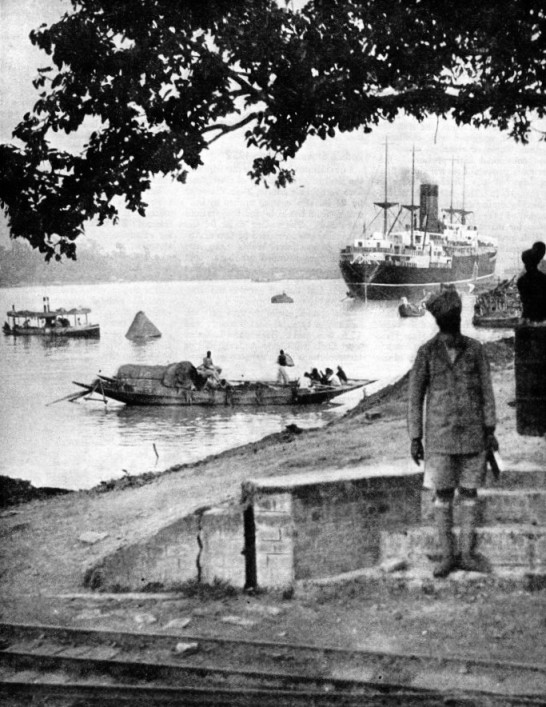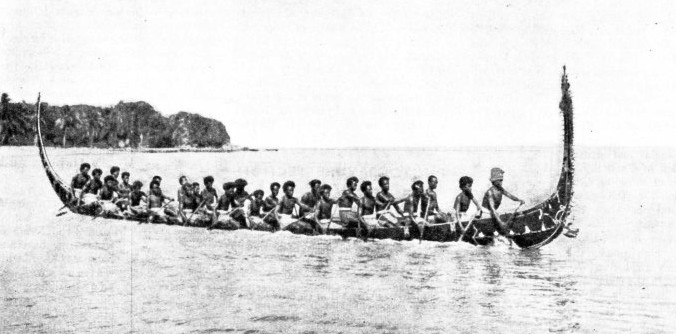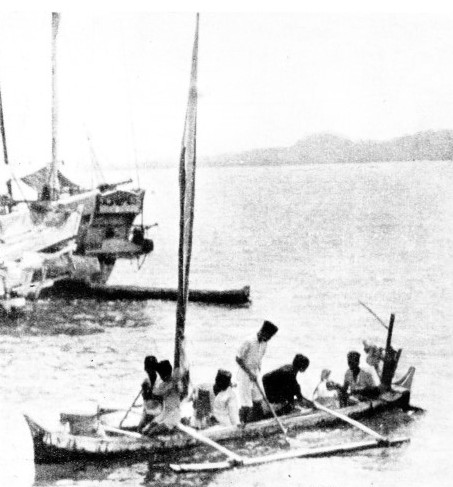Remarkable yet primitive vessels are still built in remote places of the world, often without adequate material, but always with a skill that has been inherited through many generations

THE EAST AND THE WEST provides a picturesque contrast on the River Hooghly at Calcutta. The steamer in the background and the steam launch on the left are Western products, but the river craft in the foreground is of a type that has been unchanged for centuries. One type of native passenger boat used on the Hooghly is known as a dinghy, a term applied also to small boats towed or carried by yachts.
MILLIONS of natives in the Far East make use of craft having only two main points of resemblance to the boats and small vessels of the West: these craft are built of wood and they float. Some, such as the Arab dhow and the Chinese junk, are seaworthy vessels. Before the steamship clipped the wings of sail, they played an important part in carrying goods across the seas east of Suez and were the main links in the chain of communication from East to West. For local trade these vessels still defy steam and the internal combustion engine. Smaller craft are used for fishing in tropical seas, and still smaller ones for river fishing. Others are floating homes and cargo carriers on rivers and canals.
Man power being cheaper than diesel oil and petrol in the East, paddles, sweeps and sails continue to propel craft, the design and rig of which have remained practically unaltered for centuries. Here and there an idea has been taken from the white man, but only by natives of the coast in contact with the West. The vast majority of natives build their boats and handle them just as their ancestors did. Although a European boat specially designed for local needs may be the more efficient craft, more seaworthy and capable of carrying more cargo with fewer hands, she is unable to win favour and make a place for herself. The native craft is built of local materials in a time-honoured way and sailed or paddled by men who have been accustomed almost from the cradle to manage her according to tradition. Every vessel represents a compromise between what man wants to do and what wind and water permit, and in no craft is this more exemplified than in the small boats built by natives.
Some craft, especially river boats, are extremely primitive and scarcely merit their appellation; but others are most ingenious, and require skill in management. Properly handled, such boats accomplish remarkable passages, and when the white man tries to handle them he realizes the skill of the native.
The smaller craft on the coasts vary in design according to local conditions, for not only does the native have to build his boat to suit the Waters in which she is to operate, but he has also to do his best with local material. He is often too poor to buy better material, which would have to be brought some distance. Instead of using canvas for sails, he may have to make his sails of matting, and his halyards and sheets may be of grass rope. Before the coming of the white man, with his iron nails and edge-tools, the canoe craftsmen of the South Sea Islands had to build seaworthy canoes without the aid of iron.
We are still apt to think of the Arab as a desert-nomad and to forget that he has for centuries been a seafarer from whom the European has learnt much. The lateen sail, which in one shape or another is the favourite rig of vessels seen in Indian waters, in the Persian Gulf and Red Sea, far down the coast of East Africa, and from the Levant to the Straits of Gibraltar, is a sign of the Arab’s knowledge of the sea. That tremendously long, curved yard and the short mast look strange at first to eyes accustomed to the tall masts, straight gaffs and heavy booms of the fore-and-aft rigged vessels of northern seas.
The triangular lateen sail which gave the felucca and other Mediterranean vessels a reputation for speed is said to have originated from the Arab dhow. So long and heavy is the yard that sometimes two spars are fitted to give the requisite length. When the sail is furled and the vessel is at anchor the yard, with the sail furled to it, is kept clear of the deck. The yard is hoisted, the heel is made fast to the deck by the tack-purchase, and the peak is topped up to the required angle. When the sail is furled ropes called brails are used to control it. As there are no Trade Winds in the Mediterranean this triangular loose-footed sail, which can be quickly adjusted to a variety of angles and swiftly furled in a squall, has proved more serviceable for the great inland sea than the square-rig.
With an exceptionally high peak, the lateen sail distinguishes the gaiassa of the River Nile, a note-worthy river boat, generally two-masted. The unusually high stem of these river boats is probably a legacy from ancient times When running before the wind the two sails are goosewinged (one sail set to port and the other sail set to starboard). When beating against the wind the high peak catches the wind that blows over the banks of the river; this wind would be missed by a low-setting sail. The yard of the mainsail is longer than the boat, as a rule. Although the spring in the yard spills some of the wind out of the sail when close-hauled on a stiff breeze, this play lessens the danger of capsizing, as these boats are shallow.

The Arab dhow is fast for its size, and has a long overhang forward and a raked stern. Dhows vary in size from between fifty and eighty-five feet overall, the larger ones making passages to Africa and India. As both the African and Asiatic shores of the Red Sea are fringed by reefs, with passages possible for small craft but not for deep-draught naval vessels, dhows running guns or slaves were safe from warships while they were behind the barrier. The task of dealing with them thus fell to the junior officers in charge of naval cutters. A trick which the Arabs tried when boarded was to lower the lateen sail with a run, so that the naval men were trapped under the canvas and stabbed while they were struggling to get free. The British naval patrols, however, soon overcame this ruse. The dhow and adaptations of the type occur all down the west coast of India as far as Colombo, in Ceylon. The native of India was no more capable of building a sea-going ship and sailing her than was the native of Africa and America. Indeed, the boats on the rivers and canals of India are almost as primitive as the boats in use on the Nile several thousand years ago. India’s contribution to the story of the sea is the name dinghy, which is now applied to a small boat carried or towed by a yacht, but is really that of a passenger boat seen on the River Hooghly at Calcutta. Even this craft, in its native form, resembles the ancient Egyptian boat.
It is extraordinary that the Indians, walled in from the rest of Asia by the mighty Himalayas, did not seek intercourse with the world by building ships; but the fact remains that the various races inhabiting the subcontinent are primarily landsmen.
The boat, however, plays an important part in the life of multitudes of people throughout India, even if they live in the shadow of the world’s greatest mountains.
The rivers, canals and lakes are crowded with primitive craft that often form floating homes for families. On some rivers, such as the Sutlej, one of the oldest forms of water transport is used - inflated bullock skins. The skin floats on its back and the native lies across it, steering with his feet and paddling with his hands.
Some of the fishing craft in India are very primitive; but men catch fish froln them, and they are thus sufficient for the purpose and justify their existence. The catamarans in use in southern India are often nothing more than a few logs lashed together by means of two cross-poles and rope. Sometimes an attempt is made to raise the freeboard by tilting the outside logs, which are shorter than the middle ones, so that the whole resembles the shape of a boat. One plank about two feet wide forms the flat bottom of the shikara, used by the lake fishermen of Kashmir. Two sides are shaped from two other planks. This boat has a platform at the stern upon which the fisherman balances himself while waiting with his pronged fish-spear. Spears and arrows are part of the equipment of the Indian fisherman, and some of the natives have improved on the bow by copying the crossbow introduced by the Portuguese when Vasco da Gama reached India centuries ago.
The outrigger canoes and dug-outs of Ceylon introduce a type which is employed throughout the Pacific. Instead of putting a keel on to his hollowed-out tree trunk, the native solved the problem of stability by lashing two poles athwart the dug-out with floats attached, so that when the dug-out began to capsize either to port or starboard the floats buoyed it up. Lacking beam, the outrigger must always be unstable, but it is a useful craft in sheltered waters, and when under sail before the wind is astonishingly fast. A development of it is to fasten two canoes so that they form two floats; goods and passengers are carried on the platform between.
In the sheltered lagoons of the Pacific Islands the natives use large canoes with large single outriggers, and pile on to the struts a surprising amount of cargo, considering the flimsy nature of the craft.
It is said that the Polynesians who peopled the far distant islands such as Tahiti, the Marquesas and New Zealand came by way of India and the East Indies; but their great canoes were bigger craft than the outriggers. The outrigger is not suitable for rough water because of the strain on the struts from the action of the waves; but in sheltered waters it continues to survive. It draws only a few inches of water and its construction has been brought to a fine art by the skilful craftsmen of Eastern Polynesia, where each island strives to outdo its neighbour, and the outrigger races are the sporting event of the year.
These swift outrigger canoes are carefully housed in boathouses ashore or placed on a platform above the waters of the island lagoon and screened from the heat of the sun by leaves. In strong winds one or two men stand on the outrigger to balance the craft as she scuds before the wind, or with a beam wind. Speeds as high as seventeen knots are claimed by white men who have sailed in these craft, but the writer has never been able to verify them.
Outriggers are useless in a headwind, as they have no grip on the water. The native furls his sail and paddles home at the end of the course. It is interesting to race one of these craft with an orthodox centre-board sailing boat on an out-and-home course, with the stipulation that the centre-board boat must not be paddled or rowed. The result depends upon the force of the wind and the direction of the course. Off the wind the outrigger has things her own way, but with a beam wind the centre-board boat benefits, and with a head wind the result depends upon the strength of the paddler in the outrigger and upon the skill of the helmsman in the rival boat.
Before the wind the float of the outrigger comes out of the water as the canoe rolls, and the man on the strut leans outboard to prevent the vessel from capsizing. It is hard work for a novice to steer with the paddle, as at speed it needs force to keep the paddle in the water, to say nothing of steering the canoe.
The duck-boat of Burma and Siam, (so called because the shape of the hull resembles the underside of a duck) is a seaworthy type, with beam and stability, and can carry plenty of sail. But the Malayan boats are shallow, light and long. The pirates of the Malay Archipelago relied on the paddle and on shallow draught. Because of the light winds sailing ships were slow in passing the Malacca Strait and were easily overtaken by the pirates paddling these light craft. The shoal draught enabled the pirates to escape over the bars of rivers where the water was too shallow for the deeper draught boats of the British Navy sent in pursuit of them. By paddling into the creeks the pirates were able to hide until their pursuers had given up the chase. Lake Titicaca, high up in the Andes of South America, is navigated by boats called balsas. The boats are built of two balsa-tree logs connected by a framework, or wickerwork. The wood is extremely light and is used for constructing rafts.
Millions of Chinese live afloat in the river, lake and canal boats, and the Chinese junk is one of the most seaworthy ocean-going vessels of the world. Many of the ideas of the West have been realized for centuries in China. The overhanging stern which enables the fisherman to haul his net: leeboards to enable a shoal-draught boat to get a grip of the water and to prevent leeway in a beam or head wind: the drop rudder which serves the same purpose: the water-tight compartment, and well-setting sails easily handled are among the points which make the Chinese vessels instructive. In addition the Chinese is a good seaman and a clever Waterman.
The Chinese sail, stiffened with battens, is as distinctive as the lateen sail. It is hoisted on a pole-mast, and each batten is connected with the main sheet. Double topping lifts on either side of the sail provide “lazy lines” into which the sail falls when lowered. To reef, the halyard is slacked and the sail sags into the topping lifts until several battens are lowered.
 A distinctive sail is that of the double canoes of the islanders of Mailu, off New Guinea. This sail, resembling a crab’s claw, is seen also at Port Moresby, capital of Papua, New Guinea. The first stage in building these strange craft is to get two dug-out canoes. A new canoe is selected as the canoe proper, over which the mast is to be stepped, and an old canoe is used for the outrigger. The two canoes, each from thirty to thirty-five feet in length, are .placed side by side on the beach with four or five feet between them, and they are joined by struts upon which a deck is built. The sail-cloth, which consists of strips of matting sewn together, is fixed to a triangular frame composed of three stakes. Its base is curved to form the “claw” of the sail. When the sail is made the frame is withdrawn, and two gaffs, which are sufficient to keep the sail taut, are substituted. To set the sail, it is first hoisted horizontally, and then the foot is brought down and made fast to the foot of the mast.
A distinctive sail is that of the double canoes of the islanders of Mailu, off New Guinea. This sail, resembling a crab’s claw, is seen also at Port Moresby, capital of Papua, New Guinea. The first stage in building these strange craft is to get two dug-out canoes. A new canoe is selected as the canoe proper, over which the mast is to be stepped, and an old canoe is used for the outrigger. The two canoes, each from thirty to thirty-five feet in length, are .placed side by side on the beach with four or five feet between them, and they are joined by struts upon which a deck is built. The sail-cloth, which consists of strips of matting sewn together, is fixed to a triangular frame composed of three stakes. Its base is curved to form the “claw” of the sail. When the sail is made the frame is withdrawn, and two gaffs, which are sufficient to keep the sail taut, are substituted. To set the sail, it is first hoisted horizontally, and then the foot is brought down and made fast to the foot of the mast.
A PRAO AT PARE PARE, Celebes, Dutch East Indies, showing how the outrigger ensures stability for these narrow boats. The outrigger is a device used by many native boat-builders whose resources do not permit them to build boats of wide beam
Click here to see the photogravure supplement to this article.
You can read more on “China’s Mighty River”, “The Mighty Amazon” and “Open Boats of the British Coast” on this website.





 A distinctive sail is that of the double canoes of the islanders of Mailu, off New Guinea. This sail, resembling a crab’s claw, is seen also at Port Moresby, capital of Papua, New Guinea. The first stage in building these strange craft is to get two dug-
A distinctive sail is that of the double canoes of the islanders of Mailu, off New Guinea. This sail, resembling a crab’s claw, is seen also at Port Moresby, capital of Papua, New Guinea. The first stage in building these strange craft is to get two dug-